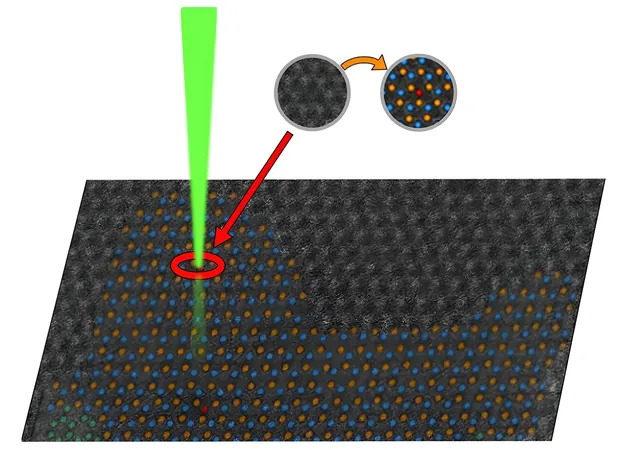
Revolutionary Technique for Observing Atomic Changes Could Unlock the Future of Quantum Materials!
2024-10-09
Author: Jacob
Introduction
A groundbreaking research team from the Department of Energy's Oak Ridge National Laboratory (ORNL) has unveiled an innovative method that could significantly transform our understanding of materials at the atomic level. This novel technique, detailed in the esteemed journal *Science Advances*, opens up new possibilities in the field of quantum computing and advanced electronic materials, setting the stage for technological advancements that could reshape our digital landscape.
The RODAS Technique
Dubbed the Rapid Object Detection and Action System (RODAS), this technique brilliantly blends imaging, spectroscopy, and microscopy methodologies. It enables scientists to capture fleeting atomic structures as they form, providing an unprecedented view of how material properties evolve on a minuscule scale—insights that could unlock tremendous potential for the next wave of quantum materials.
Traditional methods such as scanning transmission electron microscopy (STEM) paired with electron energy loss spectroscopy (EELS) have faced critical limitations. The electron beam often alters or degrades the very materials being analyzed, leading researchers to measure unintended states rather than the true attributes of the material. RODAS circumvents these issues by employing real-time machine learning alongside dynamic computer vision, allowing researchers to focus specifically on areas of interest without compromising the sample.
In a remarkable advancement, RODAS achieves rapid analysis—taking mere seconds or milliseconds—far surpassing the minutes often required by traditional approaches. This capability to extract vital information without damaging samples is a game changer for the field.
Understanding Defects
Defects—inherent imperfections within materials—play a pivotal role in determining their properties, whether electronic, mechanical, or quantum. These defects can configure themselves in a multitude of ways, intricately influenced by external factors like electron beam exposure. The challenge remains that local properties of these defect configurations are poorly understood, complicating efforts to leverage them for practical applications.
“Our understanding of defect configurations is essential for pioneering next-generation materials,” stated Kevin Roccapriore, lead author of the study at ORNL. “By mastering this knowledge, we could intricately design specific configurations that yield desired properties, which opens up thrilling new avenues for innovation.”
Capitalizing on Quantum Materials' Untapped Potential
The research team showcased RODAS' capabilities using single-layer molybdenum disulfide, a promising semiconductor desirable for quantum computing and optical technologies. This material is particularly exciting since it can emit single photons from defects termed single sulfur vacancies—imperfections that significantly enhance its electronic properties.
Understanding these single sulfur vacancies and their behavior could be revolutionary. The implications of studying molybdenum disulfide and similar materials stretch far into the realms of modern technology, with the potential to unlock groundbreaking optical and electronic applications.
A New Frontier in Material Science Awaits
RODAS signifies a monumental leap forward in the characterization of materials. Researchers can now dynamically explore structure-property relationships, target specific defects for examination, and rapidly adapt their analysis to discover new atomic classes—all while minimizing damage to the sample.
When applied to vanadium-doped molybdenum disulfide, RODAS provided crucial insights into defect formation and evolution under electron beam exposure, revealing how materials react under diverse stimuli.
As Roccapriore aptly puts it, “Advancing techniques like RODAS could be pivotal in accelerating our understanding of the physical world. Observing and analyzing materials on an atomic scale in real-time holds immense promise for pushing the boundaries of computing, electronics, and possibly even beyond.”
With this trailblazing technique, the future is brighter than ever for quantum materials and their contribution to transformative technologies that could redefine our world. Stay tuned as this research unfolds—our technological revolution may be just around the corner!









 Brasil (PT)
Brasil (PT)
 Canada (EN)
Canada (EN)
 Chile (ES)
Chile (ES)
 España (ES)
España (ES)
 France (FR)
France (FR)
 Hong Kong (EN)
Hong Kong (EN)
 Italia (IT)
Italia (IT)
 日本 (JA)
日本 (JA)
 Magyarország (HU)
Magyarország (HU)
 Norge (NO)
Norge (NO)
 Polska (PL)
Polska (PL)
 Schweiz (DE)
Schweiz (DE)
 Singapore (EN)
Singapore (EN)
 Sverige (SV)
Sverige (SV)
 Suomi (FI)
Suomi (FI)
 Türkiye (TR)
Türkiye (TR)